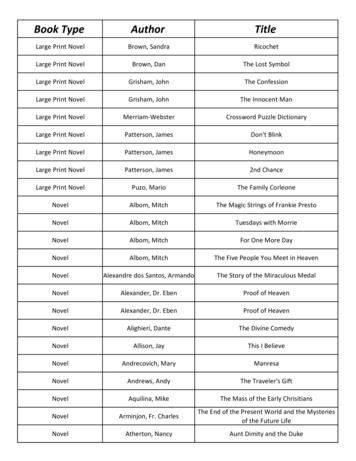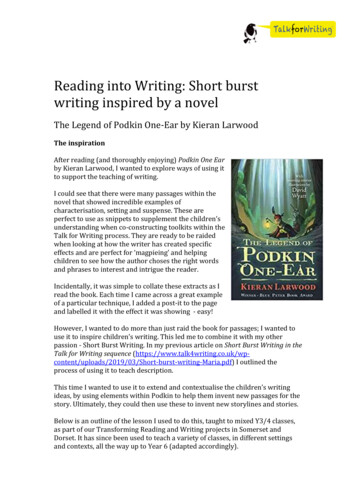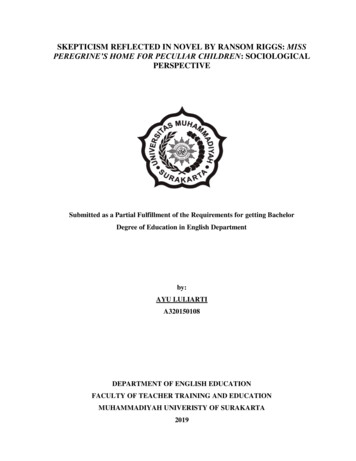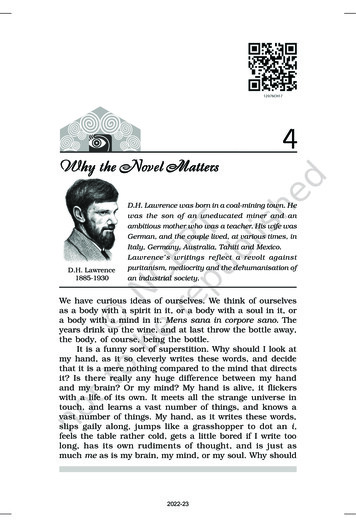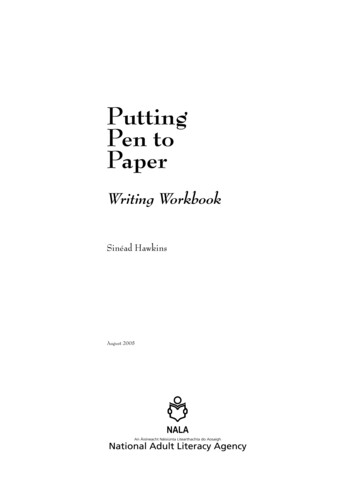
Transcription
The Novel Writing Exercises WorkbookThe Novel Writing ExercisesWorkbookExercises ForWriting A Better Novel1
The Novel Writing Exercises WorkbookCopyright 2020 Writers WriteAll rights reservedThis material is copyright under the Berne Convention. In terms of the CopyrightAct, No 98 of 1978, no part of this material may be reproduced or transmitted inany form or by any means, electronic or mechanical, including photocopying,recording or by any information storage and retrieval system, without permission inwriting from the authors. Any unauthorised reproduction of this work willconstitute a copyright infringement and render the doer liable under both civil andcriminal law. Requests to the authors and publisher for permission or enquiriesconcerning reproduction outside the scope of the above should be sent to WritersWrite at news@writerswrite.co.zaWhilst every effort has been made to ensure that the information published in thiswork is accurate, the authors and publisher take no responsibility for any loss ordamage suffered by any person as a result of the reliance upon the informationcontained herein. The advice and strategies contained herein may not be suitablefor your situation. You should consult with a professional where appropriate.Neither the publisher nor author shall be liable for any loss of profit or any othercommercial damages, including but not limited to special, incidental, consequential,or other damages.2
The Novel Writing Exercises WorkbookContents What You Need The Objectives Of This Workbook How To Use The WorkbookChapters1.Viewpoint Exercises2. Creating Characters Exercises3. Setting Exercises4. Genre Exercises5. Plotting Exercises6. Dialogue Exercises7.Beginnings Exercises8. Endings Exercises9. Pacing Exercises Bibliography3
The Novel Writing Exercises WorkbookWhat You Need1. A NotebookUse this to complete your exercises. You will have a body of writing to hold in yourhand. And keep it with you at all times. Ideas, like dreams, disappear if you don’twrite them down.2. A PenWe would encourage you to write by hand as much as possible, especially when youare creating a habit. But, you are welcome to use any tool or material that you arecomfortable with. No two methods, or two writers, are the same.3. A Character BoxLook through old magazines, cut out interesting characters. Keep them in a box.4. A Setting BoxLook through old magazines, cut out interesting settings. Keep them in a box.5. MusicCollect your favourite songs and pieces of music that inspire you. They will beinvaluable for creating moods in your writing.6. Belief In YourselfTrust your heart and your hopes. If you reach for the stars, you might not get them,but you may just get the moon.4
The Novel Writing Exercises Workbook7. PerseveranceIt’s not the best writers who get published. It’s the ones who persevere.8. An Inquiring MindBe open to new ideas and suggestions. Try. Be creative. Accept challenges. Bewilling to learn. Everyone has something that can add to your experiences.9. A Desire To Write For The Love Of Writing5
The Novel Writing Exercises WorkbookThe Objectives Of This Workbook1.To help you improve the elements of your novel.2. To help you learn more about pacing, setting, creating characters,plotting, genre, beginnings, endings, viewpoint, and dialogue.3. To complete exercises that show you how to use them in your writing.4. To have fun while you’re writing.What Are Your Objectives?1.2.3.4.6
The Novel Writing Exercises WorkbookHow To Use This Workbook1.Print out the workbook. (Or work from the digital version.)2. Set aside a time to write every day. We suggest 30 minutes to one hour.3. Keep it with you wherever you go. You may find you have spare time at oddmoments.Complete these exercises at your own pace in the comfort of your own space.Remember: You have permission to write badly!Simply put pen to paper and see where it takes you. Use the timer on your phone ifyou want, but don’t get distracted by messages and notifications. You can keepwriting after the timer has gone off, but don’t stop before then.The Purpose Of This WorkbookThis workbook complements our Writers Write – How to write a bookcourse.If you want to learn how to write a novel, please sign up for that course.If you want to improve the elements of your novel, including pacing, setting,creating characters, plotting, genre, beginnings, endings, viewpoint, anddialogue, this workbook is perfect for you.Please note that these exercises are available for free on our website. This workbookis an ADVERT-FREE compilation of those exercises.Have fun and happy writing!7
The Novel Writing Exercises Workbook3 Essential Exercises For ViewpointOn our course, Writers Write ONLINE, we spend time creating characters, plotting,learning to write dialogue, learning how to pace, and learning how to show and nottell. We teach you about viewpoint, setting, description, and scenes, and much,much more. In this workbook, we are going to concentrate on a few of these areas.We will start this workbook with exercises for viewpoint (or point of view) becausethis is how you will tell the story.When we teach, we have noticed that viewpoint confuses many writers.Viewpoint (point of view) is the filter through which you tell your story. You have tochoose a viewpoint character and you need to decide if you are going to tell the storyin first person, second person, or third person viewpoint.Using third person is the most common way to write any story. You can also write anovel as a narrator, or using a first person, or second person narrative structure.These are more unusual.8
The Novel Writing Exercises WorkbookThe viewpoint you choose should suit your story. It affects the mood of the story.1.First person is common in memoirs and Young Adult fiction. It is also usedin other genres.2. Second person is experimental and is used in more literary fiction.3. Third person is used across all genres and readers are most comfortablewith this viewpoint.4. Narrators are uncommon in modern fiction as there is too much telling whenthey are involved.MUST-READ: How Viewpoint Works – 10 Ways To Tell A StoryTo help you decide which viewpoint you are going to use, try our three essentialexercises for viewpoint to help you decide.Exercise 1: Firstly“The truth is, I hate not being the first person narrator all the way through! Toparaphrase David Copperfield, I don’t know whether I’m the hero or the victim ofthis tale. But either way, shouldn’t I dominate it?” Anne Rice, The Queen of theDamnedWrite a scene in first person present tense (present tense is often used with firstperson to make it more immediate) or past tense. (See below)9
The Novel Writing Exercises WorkbookStart with one of these:1.I look at Sam, waiting for him to sit down before I say, ‘You know, I neverwanted to kill them.’2. I picked up the binoculars and searched across the bridge. They were late.Remember:1.Name the character/s.2. Use the five senses, dialogue, body language, and the internal thoughts ofthe viewpoint character.3. Show the setting through their interaction with it.This exercise will help you find out if you enjoy the intimate, confessional nature ofthis viewpoint.Exercise 2: Secondly“You have friends who actually care about you and speak the language of the innerself. You have avoided them of late. Your soul is as dishevelled as your apartment,and until you can clean it up a little you don’t want to invite anyone inside.” JayMcInerney, Bright Lights, Big CityWrite a scene in second person present tense (this viewpoint is almost always inpresent tense) where your character wakes up in a strange room. They have no ideawhere they are or what they are doing there.Begin writing with this prompt:Your head pounds. You reach out for your glass of water, but it’s not there.10
The Novel Writing Exercises WorkbookRemember:1.Name the character/s.2. Use the five senses, dialogue, body language, and the internal thoughts ofthe viewpoint character.3. Show the setting through their interaction with it.This exercise will help you find out if you like the surreal, uncomfortable feel ofwriting in second person.Exercise 3: ThirdlyWrite an opening scene of a novel where two detectives arrive at a crime scene.Write it in third person past tense (the most common way of using third person).Use this prompt to start writing:Detective Inspector Gigi Slaughter ducked under the branches.Remember:1.Use the five senses, dialogue, body language, and the internal thoughts ofthe viewpoint character.2. Show the setting through their interaction with it.This exercise will show you that this is the easiest and most common way ofwriting a story.The Last WordUse these three essential exercises for viewpoint to decide on a clear filterthrough which you can tell your story.11
The Novel Writing Exercises Workbook5 Essential Exercises For Creating CharactersOur second chapter in this workbook includes five essential exercises forcreating characters.We find that writers don’t spend enough time creating three-dimensional charactersfor their stories. They also add too many characters instead of using one or two thatdo the same job in the story.No matter which genre you choose to write in, you should have these fourcharacters for a story to work properly. They hold your plot together.1.Protagonist2. Antagonist3. Love Interest4. Confidant/SidekickABSOLUTE MUST-READ: The 4 Main Characters As Literary Devices12
The Novel Writing Exercises WorkbookExercise 1: Physio, Socio, Psycho“When writing a novel a writer should create living people; people not characters. Acharacter is a caricature.” Ernest HemingwayCreate three biographies for your main characters and they will seem real:1.Physiological: Include detailed physical descriptions.2. Sociological: Include class, wealth, education details.3. Psychological: This is usually a combination of how they are affected by thephysiological and sociological aspects. Feelings, moods, rationalisations, andthought processes are included here. Include character traits and flaws.Decide on the ruling passions which motivate and focus your characters.Use this character sheet: The Only Character Questionnaire You NeedExercise 2: Going ShoppingWrite down a shopping list of 10 items. Send your protagonist shopping. They havejust had an argument with their love interest. Write the scene as they walk throughthe aisles thinking about the fight as they do their shopping.Remember:1.Name the characters.2. Use the five senses, dialogue, body language, and the internal thoughts ofthe viewpoint character.3. Show the setting through their interaction with it.This exercise will reveal your character’s attitude to both shopping and their loveinterest. It will really help you to show your character instead of telling us whatthey are like. P.S. Remember that love interests are perfect for sub-plots in stories.13
The Novel Writing Exercises WorkbookExercise 3: PivotWrite one of the pivotal incidents that happened in all four of these characters’childhoods that shaped them into the people they’ve become. Write it from theirviewpoint in first person present tense. (You can find some ideas for negativeexperiences here.)Remember:1.Name the characters.2. Use the five senses, dialogue, body language, and the internal thoughts ofthe viewpoint character.3. Show the setting through their interaction with it.This exercise will show your characters came from somewhere. They have abackstory. You will probably never use these scenes in your story, but you will get toknow your characters well.Exercise 4: Getting DressedWrite a scene where your antagonist gets dressed. Let them stand in front of theirwardrobe considering their options. (Write the scene in second person presenttense – if you’re brave enough to try!)Start with ‘You stand there, stretching your toned arms, admiring your reflection inthe mirror. You Remember:1.Name the characters.2. Use the five senses, dialogue, body language, and the internal thoughts ofthe viewpoint character.3. Show the setting through their interaction with it.14
The Novel Writing Exercises WorkbookThis exercise will ground your characters in the real world. They are not caricatures.They make choices. They may not care about their appearance or they may be vain.Show it in this exercise.Exercise 5: 15 QuestionsUse these 15 questions to find out more about the psychological motivations of yourimportant characters. Answer them for each of your four main characters.Click here to see it online: 15 Questions Authors Should Ask CharactersThis exercise will show the patterns of thoughts, feelings, and behaviours that makethem unique. The better you know your characters, the more memorable you canmake them.15
The Novel Writing Exercises WorkbookThe Last WordUse these five essential exercises for creating characters to make your storiescome to life. The more real your characters seem, the more your readers willempathise with them.TOP TIP: Use our Character Creation Kit to help you create great charactersfor your stories.16
The Novel Writing Exercises Workbook5 Essential Exercises For Writing About SettingPaying attention to setting does not mean that writers must tell readers about thestory’s setting in great detail. Rather, they should mostly show it (with some telling)through their characters’ interactions with that setting.A book without a well-imagined and well-conveyed setting is like watching actors ona green screen without the other elements having been added. It’s disconcerting andalienating.The unintended consequences of a lack of setting creates a series of problems forthe writer. These include wooden characters without things they need to do, a lackof empathy for the characters because readers cannot relate to their circumstances,and a lack of details that make the story come to life.MUST-READ: 12 Crucial Things To Remember About SettingTo avoid these pitfalls, try our five essential exercises for writing about setting.17
The Novel Writing Exercises WorkbookExercise 1: ChecklistUse our world-building checklist to make sure that you have really thoughtabout where you are setting your story. Fill this in before you start writing yourstory. If you have a few settings, complete the checklist for each setting.18
The Novel Writing Exercises WorkbookExercise 2: The Change IndicatorWrite about a character who comes home to find that their house has been burgled.Write the scene from the character’s viewpoint in first person present tense.Because everything has ‘changed’ in their space, you can get away with describingwhere they live and what possessions they have. If they just came home and nothingwas different, they probably would not notice much. It would seem unnatural to areader for a character to launch into thinking about their environment in detailwithout a good reason.Remember:1.Name the characters.2. Use the five senses, dialogue, body language, and the internal thoughts ofthe viewpoint character.3. Show the setting through their interaction with it.MUST-READ: 20 Questions Characters Should Answer About SettingExercise 3: Coffee TimeWrite about your character’s first cup of coffee or tea for the day. Write about wherethey make it as they make it. Show the character’s surroundings through the fivesenses and their actions.Fill this in for the character: He/she smelled He/she tasted He/she touched He/she saw He/she heard19
The Novel Writing Exercises WorkbookWrite the scene in third person past tense.Remember:1.Name the characters.2. Use the five senses, dialogue, body language, and the internal thoughts ofthe viewpoint character.3. Show the setting through their interaction with it.Exercise 4: Generic1.Write about two character meeting for the first time.2. The setting is a castle.3. The characters names are Lucille and Dmitri.4. Write the same scene in three different genres: fantasy, crime, and romance.Different genres require different setting descriptions. For example, fantasy,romance, and crime novels all require detailed descriptions, but what they describeand the tone they use to describe it are very different.Write the scenes in third person from one of the character’s viewpoints.Remember:1.Use the five senses, dialogue, body language, and the internal thoughts ofthe viewpoint character.2. Show the setting through their interaction with it.Exercise 5: A Fish Out Of WaterWrite a scene where your main character is thrust into a setting they don’tunderstand. A good example of this was Crocodile Dundee when he arrived inNew York. This uses the change indicator again and allows you to explorecharacter and setting and helps you show and not tell.20
The Novel Writing Exercises WorkbookRemember:1. Name the characters.2. Use the five senses, dialogue, body language, and the internal thoughts ofthe viewpoint character.3. Show the setting through their interaction with it.Read: 5 Ways Setting Affects Your CharactersThe Last WordUse these five essential exercises for writing about setting to help you paint abackground for your stories.If you want to create the best settings in your books, buy our Setting Up TheSetting Workbook to make your settings come to life.21
The Novel Writing Exercises Workbook3 Essential Exercises For Writing In A GenreWhen we teach, we find that sticking to a genre can be difficult for many writers.It’s important to get this right because readers like genres. They like buying andreading books that fall into a defined category. They know what to expect and theywill enjoy it more if you fulfil their expectations.As an author, genre controls what you write and how you write it. It describes thestyle and focus of the novel you write.Genre affects many things in your novels, including the following:1.Manuscript length2. Character types3. Settings4. Description lengths5. Themes6. Plots22
The Novel Writing Exercises WorkbookOnce you decide on a genre, it’s important to stick to the accepted rules of thatgenre. For example, it would be wrong to include a serial killer in a romance, or toset a generic romance in a slum.MUST-READ: The 17 Most Popular Genres In Fiction – And Why TheyMatterTo help you fit your story into a category, try our three essential exercises forwriting in a genre.Exercise 1: Communicate1.Write a scene where your main character has to tell somebody about anaccident.2. Write it in three different genres: Fantasy, Romance, Crime.3. Choose the way you will communicate. For example, you could use a letter forthe fantasy novel, a telephone call for the romance, and a text for the crimenovel.4. Focus on the style of the language and the tone.Remember:1.Name the character/s.2. Use the five senses, dialogue, body language, and the internal thoughts ofthe viewpoint character.3. Show the setting through their interaction with it.This exercise will help you focus on the way people would communicate in differentgenres.23
The Novel Writing Exercises WorkbookExercise 2: Terminology1.Write a scene from the viewpoint a wealthy individual who realises that aloved one is in danger. The character is 40-years-old.2. Write it in two different genres: Science Fiction and Literary Fiction.3. Take care to choose terminology that suits each genre.Remember:1.Name the character/s.2. Use the five senses, dialogue, body language, and the internal thoughts ofthe viewpoint character.3. Show the setting through their interaction with it.This exercise will help you find out if you like the surreal, uncomfortable feel ofwriting in second person.Exercise 3: Characterisation1.Create a character. Name them, tell us how old they are, where they live, whothey live with, where they work, and what their goals are.2. Now see if you can create them in three different genres of your choice,perhaps a Western, a thriller, and a fantasy novel.3. Create brief character sketches for each genre. Include how they dress, whatthey eat, and how they fit into their societies.4. Then write three scenes (one for each genre) where your character prepares ameal.This exercise will show you how different worlds are in different genres.The Last WordUse these three essential exercises for writing in a genre to help you tell your story.24
The Novel Writing Exercises Workbook5 Essential Exercises For PlottingIn chapter five, we’ve included five essential exercises for plotting.When we teach Writers Write ONLINE, we have noticed that writers don’t spendenough time thinking about the structure of their stories, and the most basic storystructure is a plot.Many writers get stuck at the end of the beginning or in the middle of their novelsbecause they don’t have a plan. They also discover plot holes they can’t fix.At its most basic, a plot involves two characters (a protagonist and antagonist) whohave opposing story goals. These opposing goals create conflict, which makes thenovel interesting for readers. Plots have negative beginnings, complicated middles,and generally positive endingsABSOLUTE MUST-READ: What Is A Plot? – A Writer’s Resource25
The Novel Writing Exercises WorkbookExercise 1: Everything ChangesWrite an inciting moment.This moment is an incident that changes your protagonist’s life – generally in anegative way.The antagonist is usually the cause of this.A great inciting moment is about change that leads to conflict, or conflict that leadsto change. Something happens that is important enough for your protagonist to actor react.Choose one of these openings and start writing:1.Everything changed when came back to .2. All four of ’s wives turned up for his funeral.3. She had 24 hours before they locked down the city.4. The note on her front door read: ‘You are going to die.’5. The rumours started when left. Nobody thought he’d gonewillingly.Remember:1.Name the characters.2. Use the five senses, dialogue, body language, and the internal thoughts ofthe viewpoint character.3. Show the setting through their interaction with it.This exercise forces you to start your story at a moment of crisis. If this moment isstrong enough it will give your idea the impetus it needs to become a novel.26
The Novel Writing Exercises WorkbookExercise 2: The Punishment Fits The Crime‘Life being what it is, one dreams of revenge.’ Paul GauginMUST-READ: Why Revenge Is Such A Brilliant Plot For Beginners1.Write about a life-changing event where your protagonist loses something orsomeone.2. It should be so shattering that your character is motivated to seek revenge.3. Then write a 10-point plan for how your protagonist will achieve this storygoal.Remember:1.Name the characters.2. Use the five senses, dialogue, body language, and the internal thoughts ofthe viewpoint character.3. Show the setting through their interaction with it.This exercise will show you that you need motivated characters for a novel tosucceed.Exercise 3: Motivations1.Write about why your protagonist and antagonist are motivated to achievetheir story goals.2. Write two scenes from each of their viewpoints in first person present tense.3. Include their external and internal motivations. For example, your charactercould be motivated to find a good job (external) to find a sense of self-worth(internal).27
The Novel Writing Exercises WorkbookRemember:1.Name the characters.2. Use the five senses, dialogue, body language, and the internal thoughts ofthe viewpoint character.3. Show the setting through their interaction with it.This exercise will show you if your main characters are motivated enough to carry astory of 80 000 words.MUST-READ: The 7 Qualities Of Compelling Character MotivationsExercise 4: The ListMake a list of 60-80 scenes that will make up your novel. Generally, a novel is madeup of this number.This exercise will reveal if you have enough of a story for the length of a novel. Ifyou don’t, you may want to turn your idea into a short story.Exercise 5: The EndWrite the last page of the story that you started in Exercise 1. Answer the questionthat was asked by the inciting moment in the beginning of the book.This exercise will show you that you have to end up somewhere.MUST-READ: 7 Extremely Good Reasons To Write The Ending FirstThe Last WordUse these five essential exercises for plotting to help you plan your novels. Themore you plot and plan, the easier it is to actually finish writing your stories.28
The Novel Writing Exercises Workbook5 Essential Exercises For Writing DialogueIn our sixth chapter, we’ve included five exercises for writers who are trying to writebetter dialogue.When we teach, we find that dialogue intimidates beginner writers. The best way toget over this is by writing a lot of it.Remember that great dialogue in fiction does the following four things:1. Dialogue allows us to show conflict.2. Dialogue creates tension.3. Dialogue advances the story.4. Dialogue reveals character. (Indirect characterisation)Try to make every piece of dialogue achieve one or more of these requirements.29
The Novel Writing Exercises WorkbookExercise 1: Just For FunWrite a dialogue-only scene between two inanimate objects that are normally usedor found together.Examples: pen and paper; laptop and desktop; TV show and Reality TV show;bacteria and antibiotic.This exercise will reveal tension and conflict between the two. It will also show youhow to create a dialogue-only sequence in your story. It will show you that you needto choose characters that have something to talk about.Laptop vs Desktop Example:Laptop: You don't know how lucky you are to just sit there all day, updating andscanning.Desktop: Easy for you to say. I never get to go anywhere and I have to do the bulkof the work in this household. He keeps on adding memory as if I don't have enoughto think about.Laptop: You won't believe the disgusting places he put me down today. On a coffeeshop floor. It was gross. And on his colleague's lap - you know Dave? The one Ialways tell you about. OMG. It was so uncomfortable.Desktop: Stop complaining, LT. At least you get to see things. I wonder if Dave willever visit?Laptop: Believe me, you don't want Dave here with his sticky hands and his ickybreath. And he always leans in too close to the screen. It's obscene.Desktop: I hope he disinfected you before he put you down next to me.30
The Novel Writing Exercises WorkbookExercise 2: A Tense SituationWrite a dialogue-rich scene between a protagonist and their love interest. Show howthe love interest complicates the protagonist’s story goal in some way.Examples:1. A detective who needs to get to a murder scene and his wife who wants to talkto him;2. A princess who needs to save her kingdom and her love interest who wants togo on a quest; or3. A journalist wants to get to an important interview and their love interestgoes into labour.Remember:1. Name the people.2. Use dialogue, body language, and the internal thoughts ofthe viewpoint character.3. Show the setting through their interaction with it.The dialogue in this exercise will reveal your characters’ personalities and showthem as three-dimensional people. It will also allow for conflict and tension. Loveinterests are perfect for sub-plots in stories.MUST-READ: 10 Ways To Introduce Conflict In DialogueExercise 3: Three Of UsWrite a one-page dialogue-rich scene with three characters in it. Show how thethree people all speak differently. The words they use and their speech patternsshould not be the same.31
The Novel Writing Exercises WorkbookExamples:1. The banker, the politician, and the mistress;2. The robot, the robot’s creator, and the creator’s mother; or3. The personal trainer, the actor, and the actor’s agent.Remember:1. Name the people.2. Use body language and the internal thoughts of the viewpoint character.3. Show the setting through their interaction with it.This dialogue exercise will show the characters: how old they are, how they see theworld, and how they treat other people. It will also show the relationship dynamics.Exercise 4: Eavesdrop‘I was kind of excited about going to jail the first time and I learnt some greatdialogue.’ Quentin TarantinoYou don’t have to go to jail, but you need to listen in on a conversation for thisexercise. Tape it if you can. Then write down exactly what the people said.This exercise will show you that dialogue in fiction cannot be like dialogue in reallife. Real life conversations are often vague and of no consequence. People oftendon’t even listen to one another.Rewrite the dialogue as if it were a novel. Introduce a conflict and show thecharacters.MUST-READ: 10 Dialogue Errors Writers Should Avoid At All Costs32
The Novel Writing Exercises WorkbookExercise 5: An important ConversationWrite a pivotal scene in a story, one where an important decision is made. Thisscene will propel your protagonist to their story goal.Examples:1. A woman tells her husband that she is leaving him;2. A detective interviews a suspect and discovers something odd; or3. A knight captures an enemy and discovers that all is not what it might seem.Remember:1. Name the people.2. Use body language and the internal thoughts of the viewpoint character.3. Show the setting through their interaction with it.This exercise will show you how to use dialogue to move a story forward. It willshow you how things you conceal and reveal in conversations change stories.The Last WordUse these five essential exercises for writing dialogue to practise incorporatingdialogue into all of your scenes. The more you write conversations, the better yourdialogue will become.Join us for Writers Write ONLINE for many more exercises like this (withfeedback), and learn how to write a book.33
The Novel Writing Exercises Workbook3 Essential Exercises For Writing BeginningsWhen we teach Writers Write ONLINE, we find that knowing how and where tostart a book can be challenging for many writers.As children, we were taught to set up the story
The Novel Writing Exercises Workbook 13 Exercise 1: Physio, Socio, Psycho “When writing a novel a writer should create living people; people not characters. A character is a caricature.” Ernest Hemingway Create three biographies for your main characters and they will seem real: 1.

